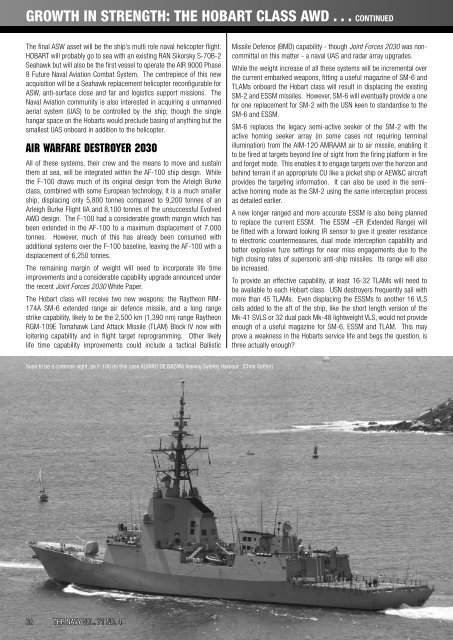VOL 71 No4 - Navy League of Australia
VOL 71 No4 - Navy League of Australia
VOL 71 No4 - Navy League of Australia
You also want an ePaper? Increase the reach of your titles
YUMPU automatically turns print PDFs into web optimized ePapers that Google loves.
GROWTH IN STRENGTH: THE HOBART CLASS AWD . . . CONTINUED<br />
The final ASW asset will be the ship’s multi role naval helicopter flight.<br />
HOBART will probably go to sea with an existing RAN Sikorsky S-70B-2<br />
Seahawk but will also be the first vessel to operate the AIR 9000 Phase<br />
8 Future Naval Aviation Combat System. The centrepiece <strong>of</strong> this new<br />
acquisition will be a Seahawk replacement helicopter reconfigurable for<br />
ASW, anti-surface close and far and logistics support missions. The<br />
Naval Aviation community is also interested in acquiring a unmanned<br />
aerial system (UAS) to be controlled by the ship; though the single<br />
hangar space on the Hobarts would preclude basing <strong>of</strong> anything but the<br />
smallest UAS onboard in addition to the helicopter.<br />
AIR WARFARE DESTROYER 2030<br />
All <strong>of</strong> these systems, their crew and the means to move and sustain<br />
them at sea, will be integrated within the AF-100 ship design. While<br />
the F-100 draws much <strong>of</strong> its original design from the Arleigh Burke<br />
class, combined with some European technology, it is a much smaller<br />
ship, displacing only 5,800 tonnes compared to 9,200 tonnes <strong>of</strong> an<br />
Arleigh Burke Flight IIA and 8,100 tonnes <strong>of</strong> the unsuccessful Evolved<br />
AWD design. The F-100 had a considerable growth margin which has<br />
been extended in the AF-100 to a maximum displacement <strong>of</strong> 7,000<br />
tonnes. However, much <strong>of</strong> this has already been consumed with<br />
additional systems over the F-100 baseline, leaving the AF-100 with a<br />
displacement <strong>of</strong> 6,250 tonnes.<br />
The remaining margin <strong>of</strong> weight will need to incorporate life time<br />
improvements and a considerable capability upgrade announced under<br />
the recent Joint Forces 2030 White Paper.<br />
The Hobart class will receive two new weapons; the Raytheon RIM-<br />
174A SM-6 extended range air defence missile, and a long range<br />
strike capability, likely to be the 2,500 km (1,390 nm) range Raytheon<br />
RGM-109E Tomahawk Land Attack Missile (TLAM) Block IV now with<br />
loitering capability and in flight target reprogramming. Other likely<br />
life time capability improvements could include a tactical Ballistic<br />
Missile Defence (BMD) capability - though Joint Forces 2030 was noncommittal<br />
on this matter - a naval UAS and radar array upgrades.<br />
While the weight increase <strong>of</strong> all these systems will be incremental over<br />
the current embarked weapons, fitting a useful magazine <strong>of</strong> SM-6 and<br />
TLAMs onboard the Hobart class will result in displacing the existing<br />
SM-2 and ESSM missiles. However, SM-6 will eventually provide a one<br />
for one replacement for SM-2 with the USN keen to standardise to the<br />
SM-6 and ESSM.<br />
SM-6 replaces the legacy semi-active seeker <strong>of</strong> the SM-2 with the<br />
active homing seeker array (in some cases not requiring terminal<br />
illumination) from the AIM-120 AMRAAM air to air missile, enabling it<br />
to be fired at targets beyond line <strong>of</strong> sight from the firing platform in fire<br />
and forget mode. This enables it to engage targets over the horizon and<br />
behind terrain if an appropriate CU like a picket ship or AEW&C aircraft<br />
provides the targeting information. It can also be used in the semiactive<br />
homing mode as the SM-2 using the same interception process<br />
as detailed earlier.<br />
A new longer ranged and more accurate ESSM is also being planned<br />
to replace the current ESSM. The ESSM –ER (Extended Range) will<br />
be fitted with a forward looking IR sensor to give it greater resistance<br />
to electronic countermeasures, dual mode interception capability and<br />
better explosive fuze settings for near miss engagements due to the<br />
high closing rates <strong>of</strong> supersonic anti-ship missiles. Its range will also<br />
be increased.<br />
To provide an effective capability, at least 16-32 TLAMs will need to<br />
be available to each Hobart class. USN destroyers frequently sail with<br />
more than 45 TLAMs. Even displacing the ESSMs to another 16 VLS<br />
cells added to the aft <strong>of</strong> the ship, like the short length version <strong>of</strong> the<br />
Mk-41 SVLS or 32 dual pack Mk-48 lightweight VLS, would not provide<br />
enough <strong>of</strong> a useful magazine for SM-6, ESSM and TLAM. This may<br />
prove a weakness in the Hobarts service life and begs the question, is<br />
three actually enough?<br />
Soon to be a common sight, an F-100 (in this case ALVARO DE BAZAN) leaving Sydney Harbour. (Chris Sattler)<br />
08 THE NAVY <strong>VOL</strong>. <strong>71</strong> NO. 4

















